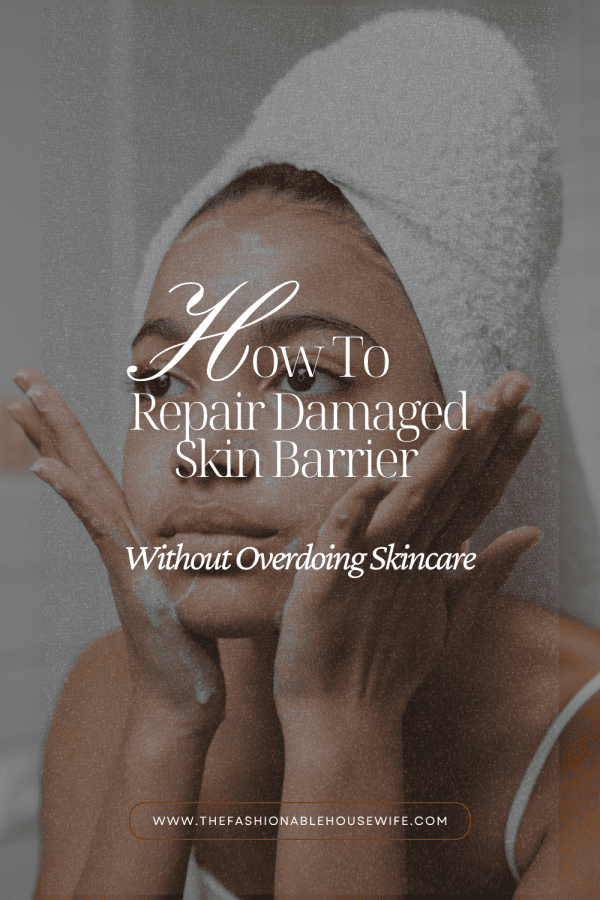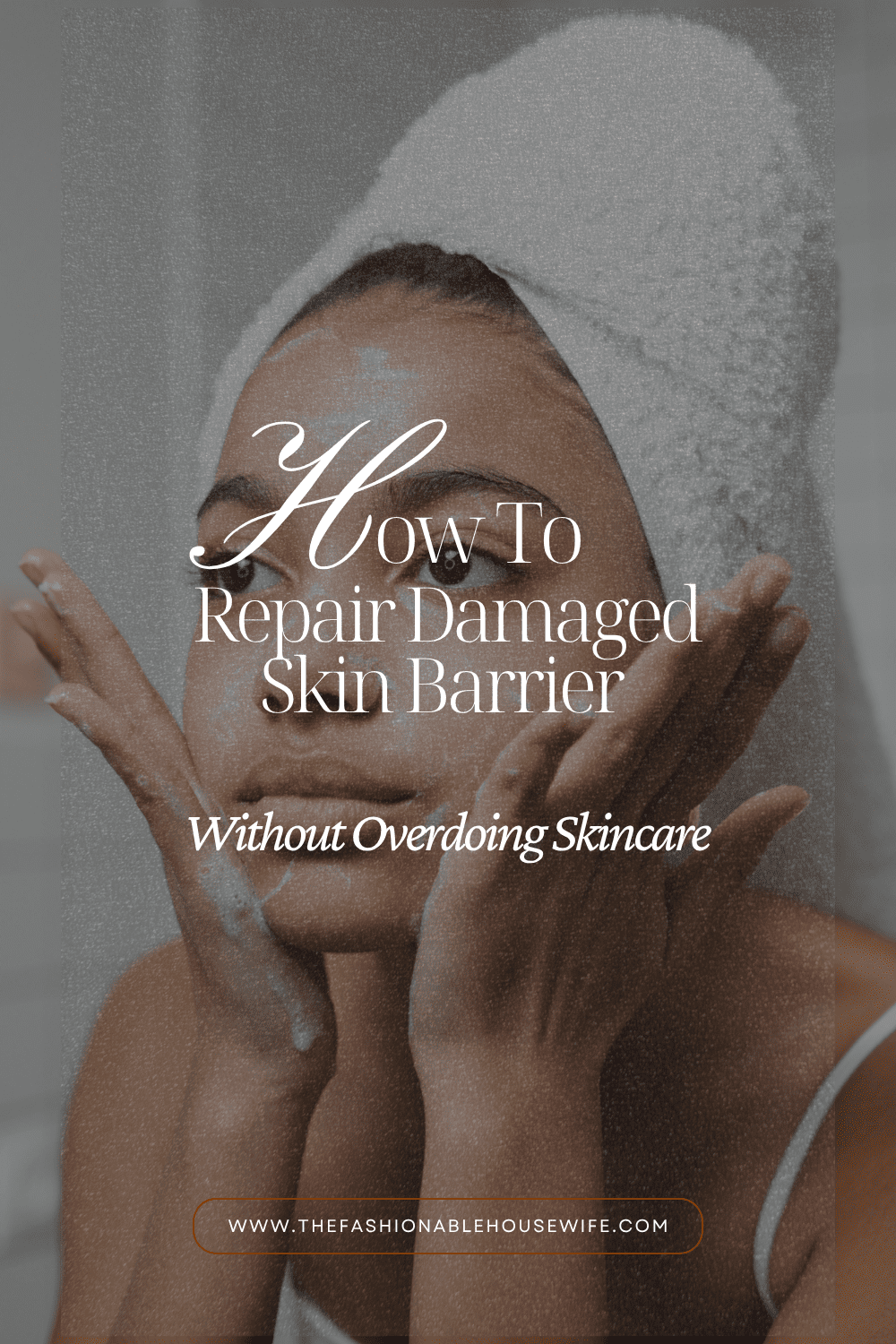How to Repair Damaged Skin Barrier Without Overdoing Skincare

Does your skin sting when you apply products that never caused irritation before? Your skin barrier consists of lipids, ceramides, and dead skin cells forming a protective seal that maintains hydration and blocks irritants. Damage to this barrier causes increased transepidermal water loss (TEWL), leading to dryness, sensitivity, and inflammation. Barrier repair may involve specific ingredients in controlled amounts – ceramides, niacinamide, and cholesterol in appropriate ratios may help restore normal barrier function when applied consistently.
The challenge of barrier repair lies in the tendency to apply multiple products simultaneously, which can disrupt the healing process. Over-treated skin may experience prolonged inflammation, delayed recovery, and secondary sensitization to previously tolerated ingredients. Repair may benefit from a minimalist approach using few targeted products, allowing adequate time between introducing new ingredients. A minimalist, targeted skincare routine—guided by specialists from a dermatology clinic Singapore—can help restore balance effectively while minimizing further irritation.
Recognizing Barrier Damage
Compromised barriers display measurable changes in skin physiology. pH levels rise above the normal 4.5-5.5 range, creating an environment favorable for harmful bacteria while inhibiting beneficial microbiome species. Water content in the stratum corneum drops compared to normal levels.
Visual indicators include fine cracks visible under magnification, uneven texture with rough patches, and redness that persists after gentle cleansing. The skin develops a shiny, stretched appearance particularly noticeable on cheeks and forehead. Products that previously caused no reaction now trigger stinging or burning within seconds of application.
Tactile changes accompany visual symptoms. The skin feels simultaneously oily and dry, producing excess sebum while remaining flaky. Makeup applies unevenly, settling into dry patches while sliding off oily areas. The skin feels tight immediately after cleansing, requiring multiple moisturizer applications to achieve temporary comfort.
Stripping Your Routine to Essentials
Barrier repair begins with eliminating all non-essential products. Stop using exfoliants, retinoids, vitamin C serums, and alcohol-based toners immediately. These ingredients, while beneficial for healthy skin, prevent barrier restoration by maintaining inflammation and disrupting lipid organization.
Your emergency repair routine requires three products only:
- A gentle pH 5.5 cleanser
- A ceramide-based moisturizer
- Mineral sunscreen with zinc oxide or titanium dioxide
Cleanse once daily in the evening using lukewarm water at 30-32°C. Morning cleansing with water alone preserves natural lipids produced overnight.
Apply moisturizers to damp skin within 60 seconds of cleansing to trap moisture. Use the amount that absorbs completely within 2-3 minutes – excess product sits on the surface without penetrating. Mineral sunscreen provides protection without chemical filters that may irritate compromised skin.
Strategic Ingredient Selection
Ceramides restore barrier lipids directly, with ceramide NP, ceramide AP, and ceramide EOP matching skin’s natural composition. Products containing all three ceramide types in combination with cholesterol and fatty acids mimic the skin’s natural lipid structure. The frequency and duration of ceramide product application should be determined by a healthcare professional or dermatologist.
Did you know?
Ceramides naturally decrease with age, explaining increased dryness and sensitivity in mature skin.
Niacinamide stimulates ceramide production while reducing inflammation. The appropriate concentration and application method should be determined by a healthcare professional, particularly for sensitive skin. Niacinamide also regulates sebum production, addressing the oily-yet-dry paradox of damaged barriers.
Centella asiatica extracts – including madecassoside and asiaticoside – may support barrier repair through increased collagen synthesis and reduced inflammatory markers. These compounds work with ceramides, enhancing penetration and retention in the stratum corneum.
Application Techniques That Protect
The method of product application impacts barrier recovery. Rubbing or massaging products creates friction that may further damage compromised skin. Instead, use a pressing motion – apply product to fingertips, gently press onto skin, and lift straight up. This technique, called “stamping,” delivers ingredients without mechanical irritation.
Layer products from thinnest to thickest consistency, allowing 30-60 seconds between each. Water-based serums go first, followed by emulsions, then creams or ointments. This sequence ensures optimal penetration without dilution or pilling.
Temperature affects product absorption and skin response. Products stored at room temperature cause less thermal shock than refrigerated items. Warm products between your palms before application to match skin temperature, reducing stress on the barrier.
Important note:
Consult a healthcare professional for appropriate application methods during barrier repair. Applying products to completely dry skin may cause friction and micro-tears. Consider maintaining slight dampness from water or a hydrating toner as advised by your skincare professional.
Timeline for Recovery
Days 1-7 mark the acute phase where inflammation subsides and TEWL begins decreasing. Redness reduces noticeably, though skin remains sensitive. Maintain the three-product routine strictly without additions. Document your skin’s response with photos under consistent lighting.
Weeks 2-3 show measurable improvement in hydration levels and texture. The tight sensation after cleansing disappears. Flaking reduces significantly. One additional hydrating ingredient like hyaluronic acid at 0.5-1% concentration may be introduced if skin shows no adverse reactions.
Week 4 typically marks functional barrier restoration for mild damage. Skin maintains hydration for 8-12 hours without reapplication. Sensitivity to previously tolerated products resolves. Severe damage may require 6-8 weeks of consistent repair protocol.
What Our Dermatologist Says
The skin’s repair mechanisms work with minimal interference. A healthcare professional may suggest the “barrier reset” – three weeks using only cleanser, moisturizer, and sunscreen. This approach may help resolve many cases without prescription intervention.
The urge to accelerate healing with additional products typically backfires. Each new ingredient introduces potential irritants and allergens when the barrier cannot properly exclude them. Patience during the initial repair phase prevents the cycle of damage and attempted repair that characterizes chronic sensitivity.
Preventing Future Damage
Barrier damage often results from ingredient incompatibilities and overuse of active ingredients:
- Retinoids and benzoyl peroxide used simultaneously cause excessive dryness
- AHAs and BHAs combined with retinoids overwhelm the skin’s tolerance
- Vitamin C serums with pH below 3.5 used daily strip natural oils
Environmental factors contribute equally to barrier compromise:
- Indoor heating drops humidity below recommended levels, increasing TEWL
- Hot water above 38°C dissolves intercellular lipids
- Harsh cleansing tools like brushes or rough washcloths cause mechanical damage
Quick tip:
Test your cleanser’s compatibility by washing your face and waiting 5 minutes – if your skin feels tight or uncomfortable without moisturizer, the cleanser may be too harsh for daily use.
Maintain barrier health through consistent protection:
- Apply moisturizer within 3 minutes of showering when skin is most permeable
- Use a humidifier to maintain humidity in sleeping areas
- Choose fragrance-free products to minimize sensitization risk
Putting This Into Practice
- Document your current routine and eliminate all products except cleanser, moisturizer, and SPF for the first week
- Measure water temperature with a thermometer and adjust to 30-32°C for face washing
- Apply moisturizer using the stamping technique to damp skin morning and evening
- Introduce new ingredients individually with 72-hour patch testing on your inner arm
- Track improvement through weekly photos taken in identical lighting conditions
When to Seek Professional Help
- Burning sensation persists with water contact alone
- Visible wounds, bleeding, or oozing develop
- Redness spreads or develops a distinct border pattern
- Symptoms worsen after 2 weeks of simplified routine
- Swelling occurs around eyes or lips
- Yellow crusting or pustules appear
- Pain interferes with sleep or daily activities
Commonly Asked Questions
Can I wear makeup during barrier repair?
Mineral-based makeup with zinc oxide or titanium dioxide provides coverage without irritation. Avoid liquid foundations containing alcohol, fragrance, or chemical sunscreens. Remove makeup with micellar water rather than oil cleansers that require emulsification and rinsing.
How do I know when my barrier has healed?
Restored barriers maintain hydration, show no redness after gentle cleansing, and tolerate previously used products without stinging. The skin develops a smooth, even texture with balanced oil production across all facial zones.
Should I avoid all active ingredients forever?
After complete barrier restoration, reintroduce active ingredients individually at lower concentrations. Start with using actives less frequently, increasing frequency based on tolerance. Many people find their skin requires lower concentrations permanently after barrier damage.
Why does my skin get worse initially?
The initial days often show increased flaking as damaged cells shed without exfoliant assistance. This temporary worsening indicates natural desquamation resuming. Resist the urge to manually remove flakes – let them shed naturally.
Can diet affect barrier repair speed?
Omega-3 fatty acids from fish or supplements may support ceramide production. Adequate protein intake provides amino acids for structural repair. Zinc and vitamin E may contribute to wound healing and barrier function when consumed through whole foods.
Conclusion
Successful barrier repair requires three key actions: eliminating all unnecessary skincare products immediately, using only cleanser, moisturizer, and mineral sunscreen for 3-4 weeks, and applying products with gentle pressing motions rather than rubbing.
If you’re experiencing persistent burning sensations, visible wounds, or worsening symptoms after two weeks of simplified skincare, a MOH-accredited dermatologist can provide comprehensive evaluation and treatment options.

